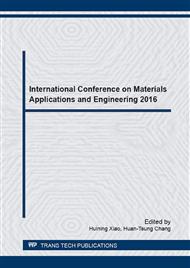p.58
p.63
p.71
p.79
p.84
p.91
p.96
p.105
p.110
Preparation of Poly Acrylic Acid Acrylamide Nanometer Material and its Drug Delivery Control Potential in Alkaline Condition
Abstract:
In order to explore a smart carrier which can control drug delivery in special pH environment, a type of nanometer material, namely, poly acrylic acid acrylamide (P(AA-AM)) was synthesized with acrylic acid and acrylamide as monomers. Its structure was determined using Fourier transform infrared spectroscopy (FTIR) and its swelling properties were tested by measuring its weight evolution. The drug delivery control potential was estimated by monitoring its swelling performances in the solutions of different pH values. The cycle characteristics were also investigated to determine its degradation properties in the environment. The results indicate that the synthesized material is sensitive to pH and is suitable for controlling drug delivery at the pH range from 10 to11 and below 7. Furthermore, this material can be automatic decomposition in the environment so that it is a degradable green material without causing burden to the environment.
Info:
Periodical:
Pages:
84-88
Citation:
Online since:
September 2016
Authors:
Keywords:
Price:
Сopyright:
© 2016 Trans Tech Publications Ltd. All Rights Reserved
Share:
Citation:


